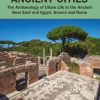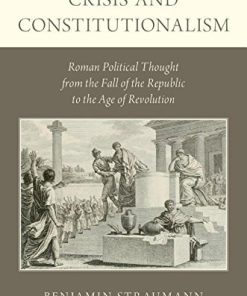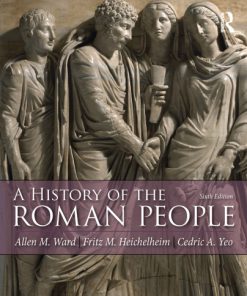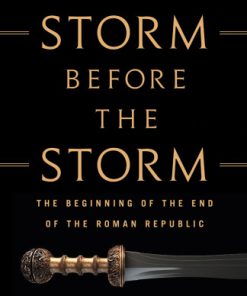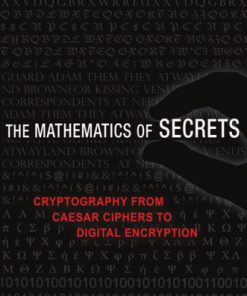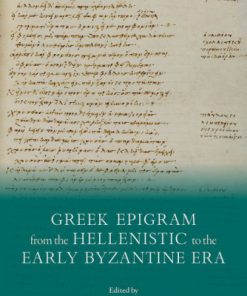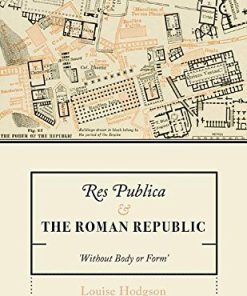The Roman Republic and the Hellenistic Mediterranean From Alexander to Caesar 1st edition by Joel Allen 1118959367 9781118959367
$50.00 Original price was: $50.00.$25.00Current price is: $25.00.
The Roman Republic and the Hellenistic Mediterranean From Alexander to Caesar 1st edition by Joel W. Allen – Ebook PDF Instant Download/DeliveryISBN: 1118959367, 9781118959367
Full download The Roman Republic and the Hellenistic Mediterranean From Alexander to Caesar 1st edition after payment.
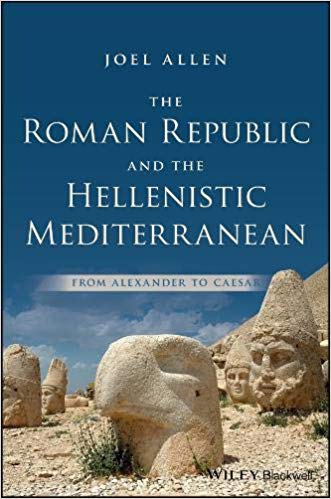
Product details:
ISBN-10 : 1118959367
ISBN-13 : 9781118959367
Author: Joel W. Allen
Broad in scope, this book uniquely considers the history of the Roman Republic in tandem with the rich histories of the Hellenistic kingdoms and city-states that endured after the death of Alexander the Great. It provides students with a full picture of life in the ancient Mediterranean world and its multitude of interconnections–not only between Rome and the Greek East, but also among other major players, such as Carthage, Judaea, and the Celts. Taking a mostly chronological approach, it incorporates cultural change alongside political developments so that readers get a well-balanced introduction to the era.
The Roman Republic and the Hellenistic Mediterranean From Alexander to Caesar 1st Table of contents:
1 To 336: Four Peninsulas and a Delta
Timeline
Principal Themes
1.1 Introduction
1.2 Bronze Age Connections and Dark Age Divisions
1.3 Resurgences of the Early Archaic Age
1.4 Political Innovations of the Archaic Age
1.5 Greeks vs. “Barbarians”
1.6 Athenian Prosperity and its Discontents
1.7 The Rise of Macedonia
1.8 Conclusions
Further Reading
2 To 336: Roman Origins and Institutions
Timeline
Principal Themes
2.1 Introduction
2.2 Italy in the Bronze and Dark Ages
2.3 The Roman Monarchy
2.4 The so‐called Struggle of the Orders
2.5 Roman Diplomacy and Empire in the Early Republic
2.6 Early Roman Society
2.7 Conclusion
Further Reading
3 To 321: Alexanders in Asia and Italy
Timeline
Principal Themes
3.1 Introduction
3.2 The Ascent of Olympias and her Family
3.3 One Alexander, in Asia
3.4 Another Alexander, in Italy
3.5 In Egypt and Mesopotamia
3.6 Absolute Power
3.7 The Second Samnite War
3.8 Imperial Styles: Persia, Rome, and Macedonia
3.9 Conclusions
Further Reading
4 To 295: An Elusive Equilibrium
Timeline
Principal Themes
4.1 Introduction
4.2 The Limits of Alexander’s Mystique
4.3 The Infrastructure of Conquest in Roman Italy
4.4 Athens under Demetrius of Phaleron
4.5 Other Western Powers: Syracuse and Carthage
4.6 Political Epiphanies
4.7 New Philosophies of Politics and Participation
4.8 The Battle of Ipsus and its Aftermath
4.9 Rome vs. Italy at the Battle of Sentinum
4.10 Conclusions
Further Reading
5 To 264: The Path of Pyrrhus
Timeline
Principal Themes
5.1 Introduction
5.2 The Education of Pyrrhus
5.3 The Collapse of Demetrius Poliorketes
5.4 Pyrrhus and Rome
5.5 Pyrrhus and Sicily
5.6 Celtic Migrations to Asia Minor
5.7 Alexandrian Erudition
5.8 The Mediterranean Without Pyrrhus
5.9 Conclusions
Further Reading
6 To 238: The Three Corners of Sicily
Timeline
Principal Themes
6.1 Introduction
6.2 The Origins of the First Punic War
6.3 The New Roman Navy
6.4 The Emergence of Minor Kingdoms in the Hellenistic East
6.5 Romans in North Africa
6.6 Boxing Matches, Part 1: The Ptolemies and the Antigonids
6.7 Boxing Matches, Part 2: Rome and Carthage
6.8 Boxing Matches, Part 3: The Ptolemies and the Seleucids
6.9 No Peace
6.10 Rome’s Cultural Mélange
6.11 Conclusions
Further Reading
7 To 201: The Expanding Roman Horizon
Timeline
Principal Themes
7.1 Introduction
7.2 Historicism in Literature: Naevius and Apollonius of Rhodes
7.3 Rome’s New Neighbors
7.4 Successors to the Successors
7.5 The Origins of the Second Punic War
7.6 Rome’s Initial Failures
7.7 Adolescent Kings in Syria and Egypt
7.8 The Five Fronts of the Second Punic War
7.9 Rome, Triumphant and Transformed
7.10 An Imperial Culture
7.11 The End of the Second Punic War
7.12 Antiochus III Becomes “Great”
7.13 Conclusions
Further Reading
8 To 186: Hercules and the Muses
Timeline
Principal Themes
8.1 Introduction
8.2 Philip V Faces East, Then West
8.3 “Freedom of the Greeks”
8.4 Romans in Spain
8.5 The Roman Wars with Antiochus III and Aetolia
8.6 Rome and the Other: Embrace and Rejection
8.7 Conclusions
Further Reading
9 To 164: Hostages of Diplomacy
Timeline
Principal Themes
9.1 Introduction
9.2 Rome as Referee
9.3 The Power of Pergamon
9.4 A New Balance of Power in the East
9.5 Spain as the Laboratory of Empire
9.6 The Plight of Perseus
9.7 The Sixth Syrian War and the “Day of Eleusis”
9.8 The Year 167
9.9 Three Celebrations
9.10 Outsiders Regarding Rome
9.11 Conclusions
Further Reading
10 To 133: The Price of Empire
Timeline
Principal Themes
10.1 Introduction
10.2 Internationalized Family Networks in Rome
10.3 Royal Pretenders
10.4 The Morality of Empire
10.5 The Carthage‐Corinth Coincidence
10.6 The Roman Reorganization of Egypt, 145–139
10.7 Economic Crisis and the Rise of the Tribunate
10.8 The Reforms of Tiberius Gracchus
10.9 Conclusions
Further Reading
11 To 101: The “New Men” of Rome and the Mediterranean
Timeline
Principal Themes
11.1 Introduction
11.2 Aristonicus and the People of Pergamon
11.3 Paos, Harsiese, and the People of Egypt
11.4 Gaius Gracchus and the People of Italy
11.5 Adherbal vs. Jurgurtha, in Numidia and in the Roman Senate
11.6 Marius and the People of Rome
11.7 A Celtic Resurgence
11.8 Shifts Among the Ptolemo‐Seleucids
11.9 Mithridates VI
11.10 So‐called Pirates and Bandits
11.11 Conclusions
Further Reading
12 To 79: Boundless Violence
Timeline
Principal Themes
12.1 Introduction
12.2 Marius and Saturninus, Cornered by/in the Senate
12.3 The Cappadocian Throne: Mithridates VI vs. Rome
12.4 The Origins of the Social War
12.5 Attempts to Recover Asia Minor
12.6 The Conclusion of the Social War
12.7 The Resurgence of Mithridates
12.8 Sulla Seizes Command
12.9 Genocide, of a Form, in Asia Minor
12.10 The Sack of Athens
12.11 Sulla’s Dictatorship
12.12 Conclusions
Further Reading
13 To 63: Extraordinary Commands
Timeline
Principal Themes
13.1 Introduction
13.2 Sertorius, Mithridates, and the “Pirates”
13.3 Spartacus
13.4 Rome Steadily Consolidates
13.5 The Consulship of Crassus and Pompey
13.6 Lucullus and the Origins of the Third Mithridatic War
13.7 Tribunes and Imperial Commands
13.8 Pompey Becomes “Great”
13.9 Rome in the Absence of Pompey
13.10 The Conspiracies of Catiline and Cicero
13.11 Conclusions
Further Reading
14 To 52: The World According to Pompey
Timeline
Principal Themes
14.1 Introduction
14.2 Pompey’s Pompa
14.3 The so‐called “First” Triumvirate
14.4 Clodius’s Imperial Tribunate
14.5 Poets and Politicians
14.6 The Scandal of the Alexandrian Embassy
14.7 Caesar in Gaul
14.8 The Return of Cicero
14.9 Displaying the “Exotic”
14.10 Challenges to the Triumvirate
14.11 Conclusions
Further Reading
15 To 44: Roman Alexanders
Timeline
Principal Themes
15.1 Introduction
15.2 Pompey’s Sole Consulship
15.3 A Planned Eastern Mission, Divisive and Unrealized
15.4 The Start of a New Civil War
15.5 Siege and Sojourn in Alexandria
15.6 Caesar in Asia, Then Africa
15.7 A Month‐Long Triumph
15.8 Caesar’s Hellenistic Capital
15.9 Conclusion: Caesar Exits a World
People also search for The Roman Republic and the Hellenistic Mediterranean From Alexander to Caesar 1st:
the roman republic and empire were egalitarian
the roman republic and empire
the roman republic religion
the roman republic and the roman empire
the relationship between the roman empire and the byzantine empire
Tags: The Roman Republic, the Hellenistic Mediterranean, Alexander, Joel Allen
You may also like…
Politics & Philosophy - Anthropology
History - American Studies
America Classifies the Immigrants From Ellis Island to the 2020 Census Joel Perlmann
History - Ancient History
Politics & Philosophy - Government & Politics
The storm before the storm the beginning of the end of the Roman Republic Michael Duncan
Computers - Security
Poetry - American Poetry
Greek epigram from the Hellenistic to the early Byzantine era First Edition Carey
Politics & Philosophy - Anthropology
Res Publica and the Roman republic: ’Without body or form’ 1st Edition Louise Hodgson
Politics & Philosophy
Politics & Philosophy - Anthropology


